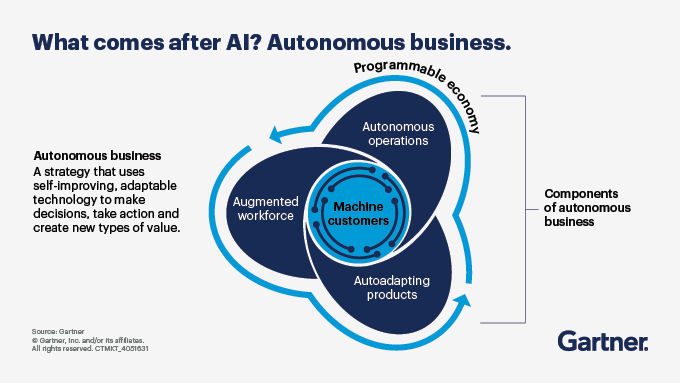Gartner warns business leaders to prepare now for the strategic disruptions of self-propelled AI.
- Gartner client? Log in for personalized search results.
Autonomous business marks a new era in enterprise transformation
At its core, autonomy describes systems that sense what’s happening and independently make decisions without waiting for human instructions. Autonomy, driven by self-improving, adaptable technologies such as agentic AI, robotics and automation, presents the next significant wave beyond digital business but already demands that executive leaders consider how they will need to recalibrate their AI ambitions and competitive strategies.
The five components of autonomous business
Here’s what AI-powered autonomy looks like in practice, and some ways it’s already playing out.
1. Autonomous operations: Systems that run themselves
Imagine if your supply chain could reroute itself during a storm or your customer service platform solved problems before anyone picked up the phone. That’s not sci-fi; it’s autonomous operations. Autonomous operations include systems that:
Keep an eye on performance around the clock
Make split-second decisions based on live data
Fix things that go off track — without a call to IT
Minimize late shipments so manufacturing managers don’t have to firefight
When operations run themselves, you spend less time fixing yesterday’s issues and more time planning tomorrow’s growth.
2. Augmented workforce: People working alongside intelligent machines
In an autonomous business, machines handle grunt work and people tackle bigger challenges — so it’s not a matter of machines taking jobs. This shift plays out with:
Teams that oversee smart systems to ensure decisions fit company values
Machines that handle repetitive tasks while employees dive into problem solving or building relationships
Leaders who invest in training so their teams move from “doers” to “guides”
Managers who help employees develop skills for collaborating with technology instead of competing against it
By 2028, Gartner predicts that 40% of services will be AI-augmented, enabling employees to focus on higher-value work as technology transforms every role.
3. Auto-adapting products: Offerings that evolve after launch
Products can now listen to users and improve themselves in real time. Consider these new possibilities:
Devices tweak settings based on how customers use them.
Software personalizes itself without endless updates.
Industrial equipment learns from its environment, cutting costs or boosting uptime.
Success hinges on adaptability, not just flashy features at launch.
Companies slow to embrace auto-adapting product strategies risk losing up to 25% market share by 2030. Businesses that meet customer expectations for real-time adaptability will gain an edge — especially in industries like healthcare, manufacturing and logistics — where precision and reliability matter most.
4. Machine customers: Nonhuman buyers changing the marketplace
Your next big customer may very well be a machine — a digital agent that purchases goods or services based on algorithms, not emotions or habits. We are already seeing:
Smart appliances reordering supplies before they run out
Bots buying inventory at prices humans only dream about
Automated systems negotiating contracts or independently scheduling repairs
Sales teams rethinking pitches to focus on speed and transparency over persuasion
By 2030, machine customers could drive or influence $18 trillion in purchases. This signals a new era where autonomy — not just automation — sets leading organizations apart.
5. Programmable economy: Seamless transactions at scale
Forget chasing invoice payments or waiting weeks for payments to clear. The programmable economy lets organizations trade instantly, without friction. It’s set apart by:
Smart contracts that handle agreements automatically
Digital twins that verify assets so trades can happen fast
Programmable money that settles payments right when terms are met
Secure ledgers that maintain transparency without slowing things down
With this foundation in place, autonomous businesses act quickly but stay compliant, giving leaders peace of mind while moving at machine speed.
Autonomous business FAQs
What is autonomous business?
Autonomous business is an emerging era in business, powered by rapid advancements in AI, that represents the next significant wave of transformation following digital business. The strategy leverages self-improving, adaptable technology — primarily agentic AI — to make decisions, take action and create new types of value.
What are the five main components of autonomous business?
The components of autonomous business are autonomous operations, augmented workforce, auto-adapting products, machine customers and programmable economy. Together and individually, they help organizations work smarter and adapt faster.
Why does Gartner call autonomous business a strategic imperative?
Autonomous business helps organizations respond quickly to change and create new value. Potentially by 2030, the impending AI-powered autonomous business world offers executives a critical opportunity to lead or face displacement by early adopters. Getting started on this journey requires a strategic rethinking of vision, products, operations and business models.
Attend a Conference
Accelerate growth with Gartner conferences
Gain exclusive insights on the latest trends, receive one-on-one guidance from a Gartner expert, network with a community of your peers and leave ready to tackle your mission-critical priorities.

Drive stronger performance on your mission-critical priorities.
